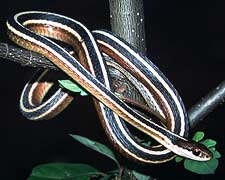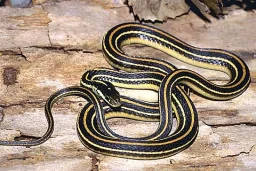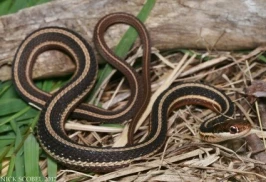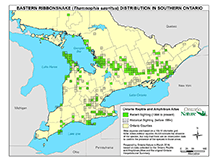Eastern Ribbon Snake (Thamnophis sauritus)
Description:
The Eastern Ribbon Snake is a slim snake with a chocolate brown or black body and has three bright long yellow stripes along its frame. Adults grow to be about 70 cm long, with females typically coming in larger. Commonly mistaken for the gartersnake, this species has a distinct small white spot in front of each eye. In late summer, the adult female will birth 5-12 young, but has been known to have up to 26! Baby snakes are independent and begin their hunt for insect prey just after birth.
Status: Special Concern Provincially and Nationally
Range:
- In Ontario, the Eastern Ribbon Snake is found throughout southern and eastern Ontario;
- Found in small parts of Quebec and an even smaller population found in Nova Scotia;
- This map, provided by Ontario Nature, shows the range in Southern Ontario for the Eastern Ribbon Snake
Habitat:
- Almost always found close to water, especially in marshes where it hunts for frogs and small fish;
- Will use forested areas for birthing sites following hibernation;
- At the onset of cold weather, the Eastern Ribbon Snakes congregate together in burrows or rock crevices to hibernate together until the spring;
- Bask along rivers edge and shoreline on logs, vegetation and low shrubs
Threats:
- The extensive loss of wetland and shoreline habitat continues to be the main threat to the species;
- Pollution has proven to participate largely in the decline of amphibian populations – thus participating in the decline of the ribbon snake;
- Road mortality is a serious threat to snakes because they are slow moving;
Protection:
- Currently listed as Special Concern under the Ontario Endangered Species Act and the Species at Risk Act ;
- Designated as a Specially Protected Reptile under the Ontario Fish and Wildlife Conservation Act;
- The habitat of the Eastern Ribbon Snake is protected by the Provincial Policy Statement under the Ontario Planning Act;
- National and Provincial Parks also offer protection under specific programs
What YOU Can Do To Help:
- Visit the Ontario Nature Organization to learn more about their Reptile and Amphibian Stewardship program;
- Between May to October, watch for snakes crossing the roads;
- Volunteer at your local Nature Club to learn more about protecting our local species and their habitats;
- If you encounter the Eastern Ribbon Snake in the wild, contact the Natural Heritage Information Centre and report your sighting;
- Visit the Adopt-a-Pond website via the Toronto Zoo to learn how you can participate in the conservation of rare snakes and their habitats
FUN FACTS:
- When the Eastern Ribbon Snake is captured, it will attempt to escape by squirming wildly and exuding a foul smelling musk to entice its release;
- The Eastern Ribbon Snake is often mistaken for the Gartersnake. However, the white crescent-shaped marking in front of their eyes can quickly identify the Ribbon Snake;
- Many snakes lay eggs, but the Eastern Ribbon Snake gives birth to live young;




